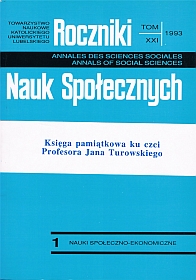The Middle-East Region in the Process of Changes
Abstract
The paper presents the problems connected with the transformation of the Middle-East Region comprising the Lublin, Biała Podlaska, Chełm and Zamość provinces − altogether, the area of nearly 23,000 km2 and 1,858,000 inhabitants.
Historically, until the end of World War II it was an ethnically differentiated region: it was inhabited by Polish, Ruthenian and Jewish population. Economically it owed its development to its fertile soils, particularly in its southern part, and to the fact that it was well situated geographically. In the 19th century the region became clearly backward and this condition has prevailed until today. After World War II the area has remained an agricultural one, without major industrial centers (apart from Lublin, Puławy, Chełm and Kraśnik), ranking among the regions with least technical investment in Poland's economic structure; it also has an adverse migration balance.
The process of property ownership transformations started in 1989 has been going on much more slowly here than in other, better developed parts of Poland: the Biała Podlaska, Chełm and Zamość provinces are ranked in the category of provinces with the lowest number of economic units in the four-degree scale used by the Chief Statistical Office (the Lublin province ranks in the third group). With respect to the rate of privatization of state-controlled firms the region ranks among the average ones, according to the data from December 1992.
The traditional backwardness of these provinces (underdevelopment of the urban network and a low proportion of the population working outside agriculture and providing a natural market for sale of agricultural products) does not allow obtaining proper effects in agriculture despite the very good soils.
Along with the process of transformation started in 1990 structural unemployment appeared. Estimated in proportion to the total of the working population it puts the region a little above the average for the whole country. However, if we refer the number of the unemployed to the amount of labor force outside agriculture (the so-called second rate of unemployment), the indices for this rate are considerably higher than the average for second rate of unemployment for the whole country.
The present economic problems of the region are to a large extent determined by the breaking of commercial and co-operative contracts with the eastern neighbors. After 1989 the region has not been a particularly attractive area for foreign investors who choose the Warsaw, Gdańsk, Poznań, Szczecin and Katowice regions much more frequently. It is the human potential that gives it a chance for future development: there are about 35 000 students in universities and academies in this region and every year about 7 000 of them take their degrees in various subjects. According to the development strategy prepared for the region its future is connected first of all with the development of agriculture and tourism.
Copyright (c) 1993 Roczniki Nauk Społecznych

This work is licensed under a Creative Commons Attribution-NonCommercial-NoDerivatives 4.0 International License.


